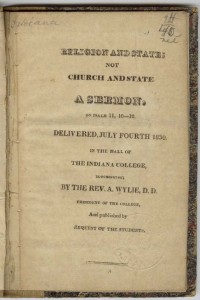Independence Day is one American holiday which unites citizens from coast to coast. Communities across the country bond over barbecues, parades, and dazzling firework displays that light up the night sky each July Fourth. This year in Indiana University’s hometown of Bloomington, students and local residents alike will take to the streets for the annual Fourth of July Parade, which runs through the heart of downtown. At dusk, a fireworks display will also be featured south of campus at the Monroe County Fairgrounds.

Back in the early days of Indiana University, the Fourth of July was already a highly regarded holiday, yet the details of celebrations were different than those of today. With the memory of American independence relatively fresh in the minds and ancestral stories of many citizens throughout the early 1800s, the initial Independence Day over which first Indiana University President Andrew Wylie presided in Bloomington on July 4, 1830 was treated as a comparatively reverent, sincere event built upon both patriotic and religious reflection. An introductory portion of Wylie’s sermon, entitled “Religion and State: Not Church and State” reads,

… I shall attempt to show, that the influence of the christian religion is necessary to the preservation of the liberties and the advancement of the general interests of this nation. And, in doing this we hope to be led into such a train of reflections as shall not be inappropriate to the general purposes of this sacred day. That the day has been set apart by God himself to commemorate the works of creation and redemption ought not to be considered as a prohibition, on the part of the Supreme Ruler of the universe, to celebrate his goodness in any other particular…
Though the aforementioned speech is highly religious in its admonitions due to Andrew Wylie’s position as a Presbyterian minister and strong religious upbringing, Wylie touches upon a variety of issues which remain relevant in the present day. His philosophical discussions on war, political party lines, corruption, morality, historical repetition, and American liberties lend insight into problems of the past which bind present-day readers to early Indiana University students through shared theoretical questions regardless of one’s religious affiliation. Should you have an interest in reading this sermon in its entirety, fortunately, all you have to do is click here to access a digital copy! To see more digitized documents from the Andrew Wylie papers, explore the finding aid by clicking on any “View items” link alongside the camera icons.

The abovementioned sermon aside, even in the 1800s, students and residents of Bloomington did indeed celebrate outside church walls. An editorial published in the July 6, 1906 edition of the Bloomington Telephone recounts Fourth of July celebrations from forty years prior, circa 1865, when the people of Bloomington gathered annually en masse in Dunn Woods, before it was home to the Indiana University campus. Town residents would dig trenches, roast beef and hogs, and feast with hundreds of people from Bloomington and the surrounding countryside. “The 4th was always the greatest day of the year,” the article concludes.
On that note, those of us at the Indiana University Archives wish you a happy Fourth of July! Whether you celebrate by attending the Bloomington parade, fireworks display, or gather for a backyard barbecue with family and friends, we hope you take a moment to remember a little bit of the history behind the holiday.
Leave a Reply